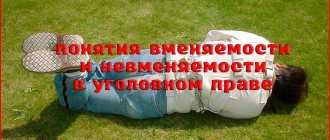Types of consequences
It is very important to note that the consequence of a crime is not any harm caused to the object of the offense, but only that which is specified in the disposition of criminal law norms. Consequences are a mandatory sign of the material elements of a crime, but in formal crimes it is optional.
By their nature, criminal results can be completely different; for example, according to qualitative indicators they are divided into two groups: material and intangible. The last option is to cause damage to legally protected interests. Intangible results can be personal or social. They can be of an environmental or political nature, be harmful to the rights and legitimate interests of citizens and organizations, negatively affect the legally protected interests of the entire state, or be informational harm.
The corpus delicti will be considered completed if a socially dangerous outcome occurs, however, there are a number of cases when, after the occurrence of some results (those included in the crime), a whole chain of further consequences that are outside the scope of the offense follows. These types of results of unlawful behavior are usually called further or additional.
According to the law, these types of outcome are not directly involved in the qualification of the crime, but if they exist, the court will make a decision taking into account aggravating circumstances.
Types and significance of qualification of crimes in criminal law
Material consequences include property and physical harm. Property damage represents both actual damage and lost profits due to a criminal act. Property damage is characterized by quantitative parameters and, as a rule, is measured in units of value. This type of damage is divided into significant, large damage and damage on an especially large scale.
Physical harm is damage that has been caused to a person’s life or health. The Criminal Code clearly describes the following types of physical harm:
- grave - this is a type of damage that is characterized by a particular danger to human life, that is, it entails loss of vision, hearing, any organ or loss of its functions, termination of pregnancy, mental disorder, etc. (Article 11 of the Criminal Code);
- of moderate severity - considered to be damage to the health of the victim that is not life-threatening and that does not entail the consequences specified in Art. 111 of the Criminal Code, but one that caused long-term health problems or loss of general ability to work (Article 112 of the Criminal Code);
- minor harm to health - short-term distress or minor loss of general ability to work (Article 115 of the Criminal Code).
In addition, the Criminal Code clearly regulates liability for beatings (Article 116) and torture (Article 117), which are not classified by the court as causing harm to health, but for which the subject of criminal proceedings is responsible.
Grounds and procedure for compensation for damage caused by the crime to the victim and other persons
13.12.: 3489
In accordance with Art. 52 of the Constitution of the Russian Federation The rights of victims of crimes and abuse of power are protected by law. The state provides victims with access to justice and compensation for harm caused. According to the criminal procedural legislation, a person is recognized as a victim of a crime if there are grounds to believe that moral, physical or property harm was directly caused to him by the crime, including as a result of a socially dangerous act committed by an insane person or a minor.
In accordance with Art. 42 of the Criminal Procedure Code of the Russian Federation, the basis for recognizing an individual as a victim is the fact that a crime caused him physical, property, and moral harm.
Physical harm consists of impairment of health, bodily harm, physical and mental suffering. Property damage is theft of property, damage and destruction of material assets. Moral harm consists of moral or physical suffering (for example, insult, humiliation, a feeling of inferiority, discomfort, physical pain) experienced (experienced, endured) by the victim as a result of an unlawful act committed against him.
When determining the amount of compensation for moral damage, the following is taken into account: the nature of the physical and moral suffering caused to the victim, associated with his individual characteristics; the degree of guilt of the defendant, his financial situation; other circumstances of the case influencing the decision on the claim.
Criminal procedural legislation recognizes not only an individual, but also a legal entity as a victim. The basis for recognizing a legal entity as a victim is the fact that the crime caused damage to its property and business reputation. The victim has the right to compensation for property damage caused by the crime by filing a civil claim.
In addition, the victim also has the right to file a civil claim for monetary compensation for moral damage, regardless of compensation for property damage.
A claim for compensation for material damage or compensation for moral damage caused by a crime can also be considered in civil proceedings. Date modified: 12/13/2019 18:04:27 Number of impressions: 3489
CAUSED BY A CRIME
Criminal acts are very diverse in their consequences. The very concept of “crime” is defined in Art. 14 of the Criminal Code of the Russian Federation and is understood as a guilty committed socially dangerous act, prohibited by the Criminal Code of the Russian Federation under threat of punishment. An action (inaction), although formally containing signs of any act provided for by the Criminal Code, but due to its insignificance, does not pose a public danger, is not a crime.
Criminal actions violate social relations, cause human suffering, disrupt physiological processes in the human body, etc., which, as a rule, inevitably gives rise to victims who are recognized as victims in criminal proceedings.
According to Art. 42 of the Code of Criminal Procedure of the Russian Federation, a victim is a person to whom moral, property or physical harm has been caused by a crime. Based on this definition, the types of harm caused by a crime are distinguished, namely: property, physical and moral harm.
It should be noted that there is no damage subject to compensation if the thing that is the object of a criminal attack is returned to the victim and its return fully restores the property rights of the victim.
If the thing is damaged or has lost its original qualities due to the fault of the accused, then the presence of property damage is obvious. In this situation, the victim can demand the amount by which the value of the thing has decreased, or demand the amount spent on repairing the thing. The victim also has the right to refuse the item, demanding compensation for its value, taking into account wear and tear.
There are no specific rules for determining the amount of damage for all cases of compensation. The amount of damage is calculated at prices in force in the relevant area and at the time of the decision.
If a crime is committed in a group, then both the perpetrators and the instigators and accomplices bear financial liability in a civil suit.
The jurisdiction of a civil claim arising from a criminal case is determined by the jurisdiction of the criminal case in which it is filed.
If the harm caused by the crime is compensated before the trial, or the person’s claim is denied in civil proceedings, then he loses the right to file this claim in criminal proceedings.
Property damage means a violation of the right to use, own and (or) dispose of property, material assets and money belonging to an individual or legal entity.
In civil law, the concept of property damage is defined as losses. According to Art. 15 of the Civil Code of the Russian Federation, losses are understood as expenses that a person (whose right has been violated) has made or must make to restore the violated right or damage to his property (real damage), as well as lost income that this person would have received under normal conditions of civil circulation, if his right was not violated (lost profits).
In criminal proceedings, property damage has a certain peculiarity. During the disclosure, investigation and consideration of a criminal case in court, the determination and proof of actual harm
, understood as the derogation of one or another property or non-property benefit, which is a specific object of encroachment. Actual harm can be caused not only as a result of offenses, but also lawful actions, for example, when detaining a criminal, as a result of necessary defense, or extreme necessity.
Please note that property damage can be caused to both individuals and legal entities.
Physical harm is expressed in disruption of the functioning of the human body associated with causing bodily harm to a person, health problems or deprivation of life.
In a legal sense, physical harm cannot be compensated; restoration of health is a medical problem. It is generally impossible to return a person’s life. Funds spent on the treatment of citizens who have suffered from crimes are subject to compensation based on the results of securing the stated claim. Medical institutions can act as civil plaintiffs. If the treatment was paid for by the victim, then in accordance with Art. 1085 of the Civil Code of the Russian Federation, the right to file a civil claim for compensation of these funds appears against the accused or against the person responsible for his unlawful behavior.
When determining the degree of harm caused by a crime, Art. 196 of the Code of Criminal Procedure of the Russian Federation provides for the mandatory appointment of an examination. The expert's opinion in this case is necessary evidence.
Moral harm as moral and physical suffering resulting from insult, as well as humiliation of honor and dignity.
The issue of recognizing moral harm as an independent type of harm caused by a crime is controversial. It is particularly difficult to distinguish moral harm, accompanied by physical suffering, from physical harm.
Physical suffering is inherently a negative reaction of the human body to stimuli. The most typical such reaction is pain - a unique psychophysiological state of a person that occurs as a result of exposure to super-strong or destructive stimuli that cause organic or functional disorders in the body[40].
In the vast majority of cases, when physical harm is caused, a person experiences pain. But this does not mean that physical harm is the same as physical suffering. These concepts are essentially different. Medical reference books indicate that an objective assessment of pain in a person is difficult, and the intensity of pain depends on a number of factors: the type of higher nervous activity of the patient, his psychological mood, emotional background, the environment in which the patient is located; in addition, strong motivations, efforts of the will of the patient himself, switching attention to some kind of intellectual activity, etc.
Physical harm as a concept objectively reflects the state of the human body. However, in some cases, when physical harm (even severe) is caused, there may be no pain, for example, when drugs and analgesics are administered or when there is a mental disorder (some forms of schizophrenia, extensive damage to the frontal lobes of the brain, alcohol intoxication). There is also an innate absence of pain (analgia). Thus, when a crime causes physical harm, situations are quite possible when pain (physical suffering) is absent.
When proving physical suffering, the first priority is to establish the fact of its existence. The occurrence of pain is accompanied by a number of changes in the body, ensuring the statics and kinetics of the body, etc. These changes are objective in nature and manifest themselves in the form of negative reactions, accompanied by an increase in body temperature, increased heart rate, etc. Any information specified in Part 2 of Art. can serve as evidence of these circumstances. 74 of the Code of Criminal Procedure of the Russian Federation, but the necessary evidence is the testimony of the victim himself, since it is he who feels the physical suffering and it is reflected in his consciousness.
An example of the difference between physical harm and physical suffering is the following situation. As a result of the crime, serious harm was caused to the citizen's health (according to the duration of the health disorder). The victim is in the hospital, unconscious. The presence of physical harm is beyond doubt, and the degree of its severity can be determined by ordering and conducting a forensic medical examination. Regarding physical suffering, we can say that the fact of their existence is probable, but there is no possibility of proving this circumstance. Any assumption about the pain experienced by the patient is probabilistic to one degree or another and, therefore, cannot be used as the basis for the conclusion of the investigator (inquirer, prosecutor) about the existence of moral harm.
Thus, moral harm must be established and proven as an independent type of harm. Being a type of harm, intangible (non-property) harm is inevitably caused both when a crime is committed to the victim, his family and friends, and when illegal actions are committed by the preliminary investigation authorities, the court and the prosecutor's office.
The basic concepts related to compensation for intangible damage are contained in Chapter 8 “Intangible benefits and their protection” of the Civil Code of the Russian Federation. Intangible benefits are a consequence of moral rights. In accordance with Art. 150 of the Civil Code of the Russian Federation, non-property rights include intangible benefits that belong to a citizen from birth or, by force of law, are inalienable and not transferable in any other way: life and health, personal integrity and good name, privacy, personal and family secrets, the right of free movement, choice of place stay and residence, right to name, right of authorship, etc.
Honor, dignity and business reputation also belong to intangible benefits. A citizen has the right to demand in court a refutation of information discrediting his dignity or business reputation, unless the person who disseminated such information proves that it is true. At the request of interested parties, protection of the honor and dignity of a citizen is allowed even after his death.
In the event of the death of a victim as a result of a crime, personal non-property rights and other intangible benefits belonging to the deceased may be exercised and protected by other persons, including the heirs of the right holder.
Subjects who have the right to protect intangible benefits are individuals who have suffered intangible harm as a result of a crime.
Legal entities have the right to compensation for non-material damage only if their business reputation has been damaged as a result of a crime.
One of the problematic issues regarding compensation for moral damage is determining its amount. When deciding on compensation for moral damage, it is necessary to take into account: 1) the guilt of the person who committed the crime; 2) the property status of this person; 3) the degree of physical and moral suffering of the victim, taking into account his individual characteristics.






